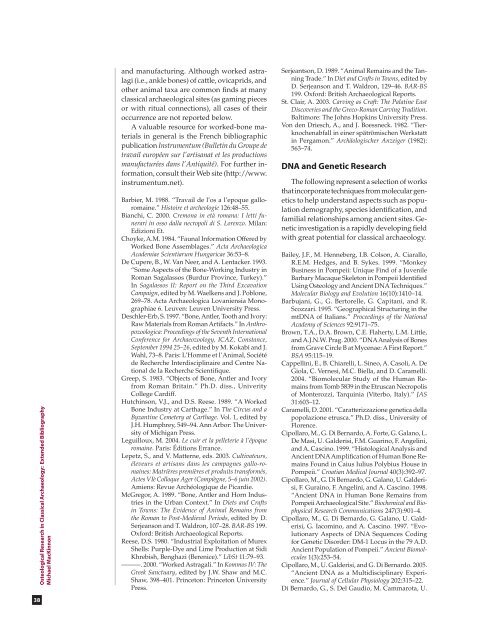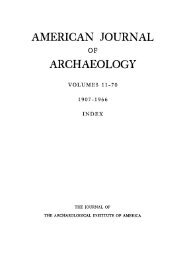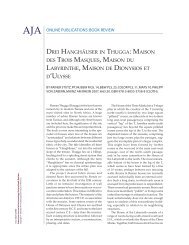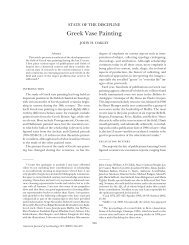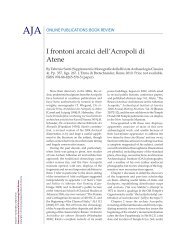AJA Online PublicatiOns - American Journal of Archaeology
AJA Online PublicatiOns - American Journal of Archaeology
AJA Online PublicatiOns - American Journal of Archaeology
Create successful ePaper yourself
Turn your PDF publications into a flip-book with our unique Google optimized e-Paper software.
Osteological Research in Classical <strong>Archaeology</strong>: Extended Bibliography<br />
Michael MacKinnon<br />
and manufacturing. Although worked astralagi<br />
(i.e., ankle bones) <strong>of</strong> cattle, ovicaprids, and<br />
other animal taxa are common finds at many<br />
classical archaeological sites (as gaming pieces<br />
or with ritual connections), all cases <strong>of</strong> their<br />
occurrence are not reported below.<br />
A valuable resource for worked-bone materials<br />
in general is the French bibliographic<br />
publication Instrumentum (Bulletin du Groupe de<br />
travail européen sur l’artisanat et les productions<br />
manufacturées dans l’Antiquité). For further information,<br />
consult their Web site (http://www.<br />
instrumentum.net).<br />
Barbier, M. 1988. “Travail de l’os a l’epoque galloromaine.”<br />
Histoire et archeologie 126:48–55.<br />
Bianchi, C. 2000. Cremona in età romana: I letti funerari<br />
in osso dalla necropoli di S. Lorenzo. Milan:<br />
Edizioni Et.<br />
Choyke, A.M. 1984. “Faunal Information Offered by<br />
Worked Bone Assemblages.” Acta Archaeologica<br />
Academiae Scientiarum Hungaricae 36:53–8.<br />
De Cupere, B., W. Van Neer, and A. Lentacker. 1993.<br />
“Some Aspects <strong>of</strong> the Bone-Working Industry in<br />
Roman Sagalassos (Burdur Province, Turkey).”<br />
In Sagalassos II: Report on the Third Excavation<br />
Campaign, edited by M. Waelkens and J. Poblone,<br />
269–78. Acta Archaeologica Lovaniensia Monographiae<br />
6. Leuven: Leuven University Press.<br />
Deschler-Erb, S. 1997. “Bone, Antler, Tooth and Ivory:<br />
Raw Materials from Roman Artifacts.” In Anthropozoologica:<br />
Proceedings <strong>of</strong> the Seventh International<br />
Conference for Archaeozoology, ICAZ, Constance,<br />
September 1994 25–26, edited by M. Kokabi and J.<br />
Wahl, 73–8. Paris: L’Homme et l’Animal, Société<br />
de Recherche Interdisciplinaire and Centre National<br />
de la Recherche Scientifique.<br />
Greep, S. 1983. “Objects <strong>of</strong> Bone, Antler and Ivory<br />
from Roman Britain.” Ph.D. diss., Univerity<br />
College Cardiff.<br />
Hutchinson, V.J., and D.S. Reese. 1989. “A Worked<br />
Bone Industry at Carthage.” In The Circus and a<br />
Byzantine Cemetery at Carthage. Vol. 1, edited by<br />
J.H. Humphrey, 549–94. Ann Arbor: The University<br />
<strong>of</strong> Michigan Press.<br />
Leguilloux, M. 2004. Le cuir et la pelleterie à l’époque<br />
romaine. Paris: Éditions Errance.<br />
Lepetz, S., and V. Matterne, eds. 2003. Cultivateurs,<br />
éleveurs et artisans dans les campagnes gallo-romaines:<br />
Matrières premières et produits transformés,<br />
Actes VIè Colloque Ager (Compiègne, 5–6 juin 2002).<br />
Amiens: Revue Archéologique de Picardie.<br />
McGregor, A. 1989. “Bone, Antler and Horn Industries<br />
in the Urban Context.” In Diets and Crafts<br />
in Towns: The Evidence <strong>of</strong> Animal Remains from<br />
the Roman to Post-Medieval Periods, edited by D.<br />
Serjeanson and T. Waldron, 107–28. BAR-BS 199.<br />
Oxford: British Archaeological Reports.<br />
Reese, D.S. 1980. “Industrial Exploitation <strong>of</strong> Murex<br />
Shells: Purple-Dye and Lime Production at Sidi<br />
Khrebish, Benghazi (Berenice).” LibSt 11:79–93.<br />
———. 2000. “Worked Astragali.” In Kommos IV: The<br />
Greek Sanctuary, edited by J.W. Shaw and M.C.<br />
Shaw, 398–401. Princeton: Princeton University<br />
Press.<br />
Serjeantson, D. 1989. “Animal Remains and the Tanning<br />
Trade.” In Diet and Crafts in Towns, edited by<br />
D. Serjeanson and T. Waldron, 129–46. BAR-BS<br />
199. Oxford: British Archaeological Reports.<br />
St. Clair, A. 2003. Carving as Craft: The Palatine East<br />
Discoveries and the Greco-Roman Carving Tradition.<br />
Baltimore: The Johns Hopkins University Press.<br />
Von den Driesch, A., and J. Boessneck. 1982. “Tierknochenabfall<br />
in einer spätrömischen Werkstatt<br />
in Pergamon.” Archäologischer Anzeiger (1982):<br />
563–74.<br />
DNA and Genetic Research<br />
The following represent a selection <strong>of</strong> works<br />
that incorporate techniques from molecular gen-<br />
etics to help understand aspects such as population<br />
demography, species identification, and<br />
familial relationships among ancient sites. Genetic<br />
investigation is a rapidly developing field<br />
with great potential for classical archaeology.<br />
Bailey, J.F., M. Henneberg, I.B. Colson, A. Ciarallo,<br />
R.E.M. Hedges, and B. Sykes. 1999. “Monkey<br />
Business in Pompeii: Unique Find <strong>of</strong> a Juvenile<br />
Barbary Macaque Skeleton in Pompeii Identified<br />
Using Osteology and Ancient DNA Techniques.”<br />
Molecular Biology and Evolution 16(10):1410–14.<br />
Barbujani, G., G. Bertorelle, G. Capitani, and R.<br />
Scozzari. 1995. “Geographical Structuring in the<br />
mtDNA <strong>of</strong> Italians.” Proceedings <strong>of</strong> the National<br />
Academy <strong>of</strong> Sciences 92:9171–75.<br />
Brown, T.A., D.A. Brown, C.E. Flaherty, L.M. Little,<br />
and A.J.N.W. Prag. 2000. “DNA Analysis <strong>of</strong> Bones<br />
from Grave Circle B at Mycenae: A First Report.”<br />
BSA 95:115–19.<br />
Cappellini, E., B. Chiarelli, L. Sineo, A. Casoli, A. De<br />
Giola, C. Vernesi, M.C. Biella, and D. Caramelli.<br />
2004. “Biomolecular Study <strong>of</strong> the Human Remains<br />
from Tomb 5839 in the Etruscan Necropolis<br />
<strong>of</strong> Monterozzi, Tarquinia (Viterbo, Italy).” JAS<br />
31:603–12.<br />
Caramelli, D. 2001. “Caratterizzazione genetica della<br />
popolazione etrusca.” Ph.D. diss., University <strong>of</strong><br />
Florence.<br />
Cipollaro, M., G. Di Bernardo, A. Forte, G. Galano, L.<br />
De Masi, U. Galderisi, F.M. Guarino, F. Angelini,<br />
and A. Cascino. 1999. “Histological Analysis and<br />
Ancient DNA Amplification <strong>of</strong> Human Bone Remains<br />
Found in Caius Iulius Polybius House in<br />
Pompeii.” Croatian Medical <strong>Journal</strong> 40(3):392–97.<br />
Cipollaro, M., G. Di Bernardo, G. Galano, U. Galderisi,<br />
F. Guraino, F. Angelini, and A. Cascino. 1998.<br />
“Ancient DNA in Human Bone Remains from<br />
Pompeii Archaeological Site.” Biochemical and Biophysical<br />
Research Communications 247(3):901–4.<br />
Cipollaro, M., G. Di Bernardo, G. Galano, U. Galderisi,<br />
G. Iacomino, and A. Cascino. 1997. “Evolutionary<br />
Aspects <strong>of</strong> DNA Sequences Coding<br />
for Genetic Disorder: DM-1 Locus in the 79 A.D.<br />
Ancient Population <strong>of</strong> Pompeii.” Ancient Biomolecules<br />
1(3):253–54.<br />
Cipollaro, M., U. Galderisi, and G. Di Bernardo. 2005.<br />
“Ancient DNA as a Multidisciplinary Experience.”<br />
<strong>Journal</strong> <strong>of</strong> Cellular Physiology 202:315–22.<br />
Di Bernardo, G., S. Del Gaudio, M. Cammarota, U.


